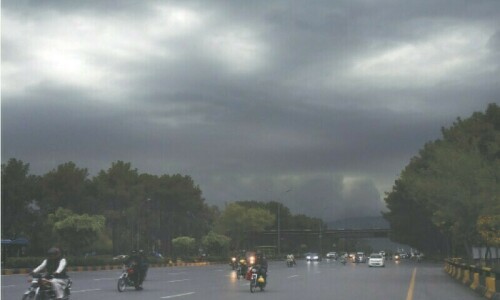HYDERABAD: The Indus River System Authority (Irsa) has been requested by Sindh to ensure stoppage of water withdrawals from Chashma-Jhelum (CJ) and Taunsa-Panjnad (TP) link canals to transfer water from Indus zone to Jhelum-Chenab (JC) zone as it is putting lower riparian Sindh at great disadvantage despite improved flows in Tarbela and Mangla dams.
Simultaneously, Sindh irrigation department has pointed out discrepancy in flows recorded at Taunsa downstream and what is actually measured by the Pakistan Council of Research in Water Resources (PCRWR).
Sindh has raised its concern with Irsa for interprovincial water distribution after the latter decided on May 13 to ensure water distribution under para-2 of the Water Apportionment Accord 1991.
Mangla, Tarbela storage full
The statistics available and information shared by irrigation sources reveal that Mangla dam had not attained a level in the early kharif period in the last 60 years which it has achieved this summer.
Tells Irsa to stop withdrawals from CJ and TP link canals by Punjab
According to the figures, Tarbela’s current storage is 39.02ft above to what was achieved in corresponding period last year. The dam’s level stood at 1,428.91ft last year in the same month against May 28 level of 1,467.93ft. It indicates better flows in the dam.
“Similarly, May 28 live storage in Tarbela is 1.76MAF when compared with 0.492MAF storage last year. This makes up for a storage differential of 1.268MAF while dam’s maximum live storage is 5.766MAF,” says an official. Wapda wants to keep storage level at Tarbela below 1,470ft due to ongoing construction constraints. Tarbela’s 31pc of total storage stands achieved.
As far as Mangla’s figures are concerned, its level was recorded at 1,184.5ft on May 28 against 1,122.5ft in corresponding period last year. “Mangla storage today is 3.345MAF against 0.869MAF recorded on May 28 last year, showing a differential of 2.476MAF,” the official pointed out while mentioning maximum live storage of 7.356MAF. He said 45pc of Mangla’s storage has also been achieved this summer.
Officials believe that these inflows are clearly indicative of impressive storage numbers in the two dams although lower riparian Sindh hardly gets inflows from Mangla dam. “Still, water flows are being drawn by Punjab [upper riparian] from Indus Zone through the CJ and TP link canals [both controversial canals from Sindh’s perspective] in interprovincial water distribution and that’s why Irsa is asked to ensure these flows are not diverted from Indus river to the Jhelum-Chenab zone,” the official says.
Sindh suffers amidst inflows
discrepancy
On the contrary, the May 28 indent of Sindh which is 140,000 cusecs for third 10 daily of May remains questionable. Sindh’s indent is ensured at Chashma Barrage which is located in Punjab instead of Guddu Barrage, first over Indus in Sindh. May 28 inflows show Taunsa’s downstream discharge is 158,682 cusecs from where inflows reach Guddu upstream.
But discrepancy in flows at Taunsa has been noted during actual discharge measurement activity conducted by the PCRWR. It has been brought to the notice of Irsa by Sindh through a May 23 correspondence.
“Huge discrepancies are being observed between actual discharge measurement activity conducted by Pakistan Council of Research in Water Resources [regarding Taunsa downstream flows that are to reach Guddu barrage eventually] and what was reported by Punjab irrigation [department] on May 21. Discharge observed by PCRWR was 92,600 cusecs whereas 104,483 cusecs was reported by Punjab, showing a difference of 11,883 cusecs”, read Sindh’s letter.
Likewise, on May 16 reported discharge was 101,244 cusecs and actual discharge was 92,100 cusecs with a difference of 9,144 cusecs. “Significant difference on continuous basis in Taunsa downstream discharges negatively impacts actual releases for Sindh by Irsa against the indent placed [by Sindh],” says the letter.
Chashma is located 518kms from Guddu and Sindh’s territorial jurisdiction starts hardly 2kms upstream Guddu barrage. “It is not technically feasible to monitor flows between this huge reach before they reach Guddu,” remarks an officer.
It was in this backdrop that on May 25, Sindh reminded Irsa about anticipated water availability and viz-a-viz actual water situation. It urged Irsa to ensure stoppage of water withdrawals from Indus zone through link canals. It says that anticipated water availability criteria 2024 approved by Irsa’s advisory committee on April 2, current level of Mangla stands at 1,109.50ft and as per anticipated criteria 2024 the reservoir would have attained 1,170.32ft level at the most. Despite these inflows link canals are transferring water from Indus although Mangla has surpassed anticipated storage level by 10.1ft.
‘Shortage stands at 29pc’
It again reminded Irsa that it had revised shortages for provinces to zero in view of improved flows but Sindh still faces ng 29pc shortage when compared with flows covered under Water Accord 1991 for May. Even after ten days of downward revision of shortages by Irsa, situation remained unchanged for lower riparian in kharif which starts early in Sindh.
Published in Dawn, May 29th, 2024













































Dear visitor, the comments section is undergoing an overhaul and will return soon.